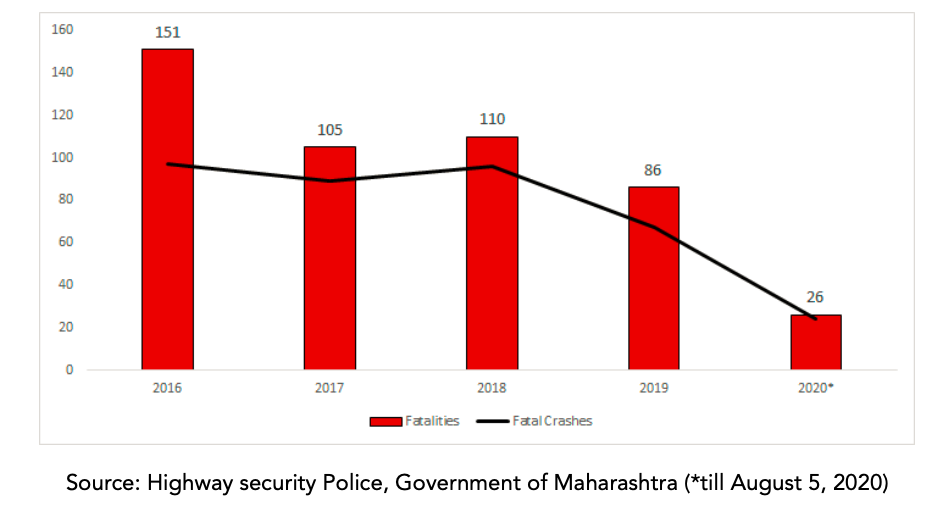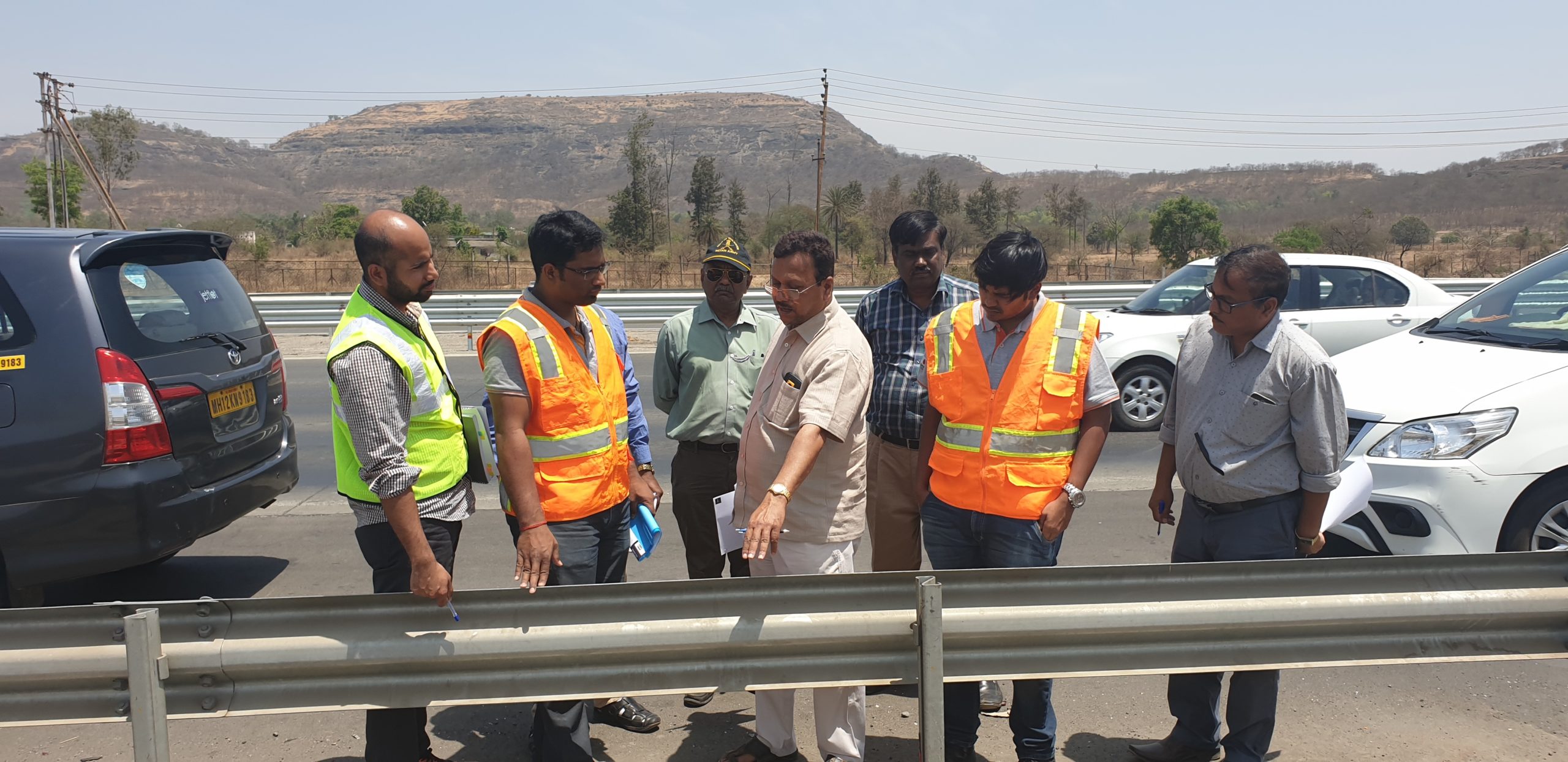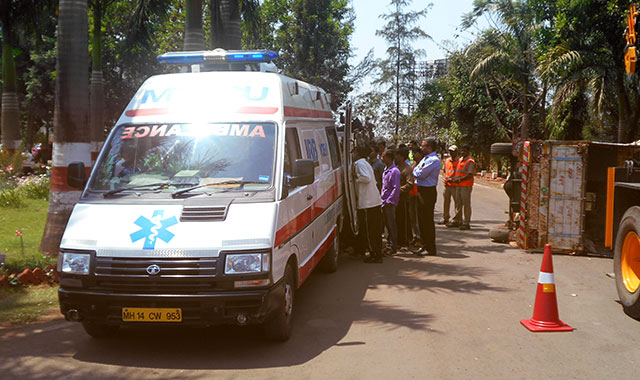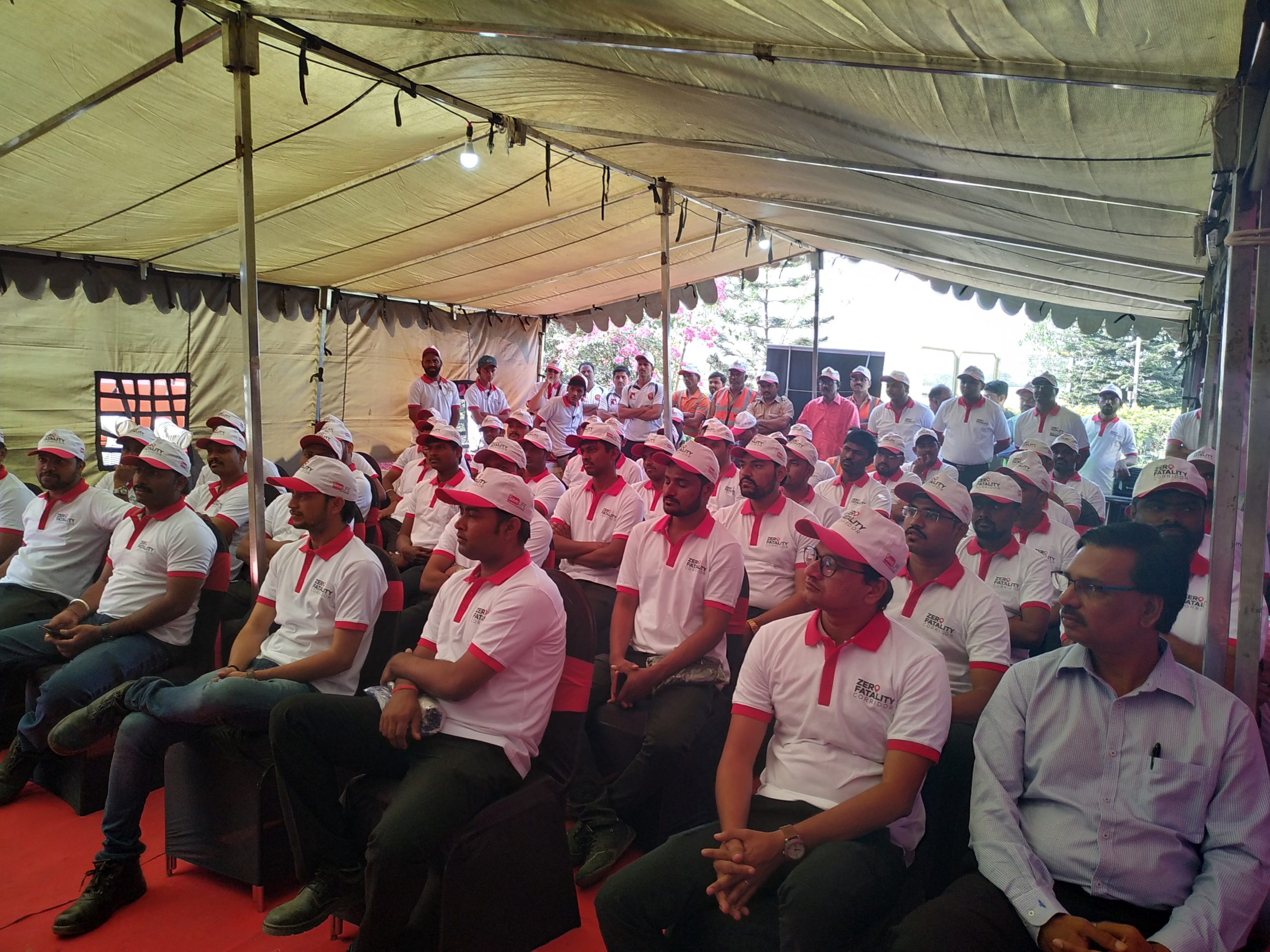
ABOUT ZERO FATALITY CORRIDOR
Why Zero Fatality Corridor Project?
According to Government of India data in the year 2015, highways including expressways constituted 2 per cent of the total road network but accounted for a share of 29.6 percent of all road crashes and 34.5 percent of the total number of persons killed, in addition to accounting for 40 per cent of the total traffic carried on Indian roads.
According to data collected from the Maharashtra Highway Police from 2011 to 2015, there have been 941 recorded road crashes on the MPEW which resulted in 641 fatalities and 1,098 injuries (926 serious and 172 minor injuries). Between 2011 and 2014 the number of road crash fatalities on the MPEW increased by 20 per cent. MPEW's annual average of over 2.5 fatalities per two kilometres of road is higher than the national average of 1 death in every two kilometres for National Highways, making it one of the most dangerous roads in the country.
About the Zero Fatality Corridor Project
The objective of the ZFC initiative is to make the Mumbai-Pune Expressway (MPEW) a model highway for road safety by reducing the number of road crash fatalities on the MPEW from an annual average of 135 to 0 by the year 2021. SLF has delivered an astounding 43% reduction in fatalities on the Mumbai-Pune Expressway through a combination of measures ranging from improved road engineering to technology-driven traffic enforcement to optimised trauma response – the Zero Fatality Corridor (ZFC) model. SLF’s current efforts are aimed at replicating the model on other highways in order to convince the Indian government to adopt the solution at scale. The following approach is adopted to implement the Zero Fatality Corridor project.
- Coalition Building:- We partner directly with local, state and national governments in India to improve road safety. Since there are multiple entities who take care of the disparate aspects of road safety, we strive to build an effective coalition which works individually, collectively and collaboratively to reduce fatalities on the adopted stretch of road.
- Evidence based approach:- We use existing government road crash data, and use the evidence to target the most crash-prone zones.
- On Site Audit:- We visit these roads, conduct forensic crash investigations ( that we now train police officials to do), and complete audits to diagnose the core safety issues.
- Solution Determination:- Basis our findings, we recommend a mix of interventions basis the “4 E’s of Road Safety”, namely Engineering, Enforcement, Emergency Care, and Education
- Solution Deployment:- We then work with government partners to ensure coordinated implementation, management and institutionalization of the “Four E’s” to bring about a reduction in fatal road crashes, bringing preventable road crash fatalities down to Zero.
- Measurement & Replication:- We measure the outcome of the solution, the best impact indicator being reduction in road crash deaths on the target road. We constantly seek to improve the solution and institutionalise the learnings into best practices to replicate the approach at scale.
Zero Fatality Corridor: Impact
Prior to the start of the project the MPEW recorded 151 road crash deaths in 2016. In the calendar year 2019, a total of 86 road crash deaths were recorded on the MPEW, a 43% decrease compared to the 2016 baseline. The crash severity in 2019, reduced to 25 % from a corresponding high of 54 % in 2016 (Crash severity is defined as a ratio of fatalities against total crashes). While the average monthly vehicles plying on the MPEW increased from 3.59 million in 2016 to 4.24 Million in 2019, the average monthly fatalities per million vehicles fell from 3.50 to 1.69 in the corresponding period.

Project Implementation
The following interventions have been undertaken in the ZFC project
1. ENGINEERING
Implement Safe System Approach to reduce infrastructural contributions to road crashes and fatalities
Implement a Safe System Approach to road engineering and design by retro-fitting counter-measures to minimize the contribution of infrastructure factors to road crashes.
- Research: Even minor engineering errors on the expressway can lead to crashes and fatalities. 2,145 issues have been identified through a detailed engineering audit and categorized into 15 subcategories.
- Recommended interventions: Counter-measures are recommended at these identified spots on the expressway to prevent future crashes.
- Implementation of counter-measures: Mahindra & Mahindra Ltd. through its CSR initiative ‘Rise for Safe Roads’ provided the requisite funds for implementation of direct counter-measures. The Government of Maharashtra (through MSRDC) has invested corresponding capital and resources to implement additional counter-measures recommended by SaveLIFE Foundation. Out of the 2,150 identified spots where engineering interventions were required, 1,125 spots have been fixed and the remaining spots are being addressed in 2020.
- Monitoring and Evaluation: Regular monthly audits of the road safety infrastructure is carried out by the Engineering Team of SaveLIFE Foundation to monitor and evaluate the progress on various issues. This is over and above the regular audit by MSRDC. Repair and replacements are regularly followed up so that risk factors can be minimised to the extent possible.

2. EMERGENCY CARE
Building a “Chain of Survival” by improving the quality and speed of care at each stage of the victim’s journey is an important objective of the Zero Fatality Corridor Project. In order to improve the quality and speed of emergency care provided to injured road crash victims SaveLIFE Foundation works with stakeholders to optimise ambulatory care through efficient data analysis and better protocols. Five 108 Ambulances have been placed on the Expressway for effective trauma response.
Improve the quality and speed of emergency care provided to injured road crash victims by developing a “Chain of survival” including interventions in on-ground care, ambulatory care, and in-hospital care.
- Research: Analysis of emergency response records on the MPEW, demonstration of the Emergency care protocols, and emergency care audits undertaken to understand how to improve emergency care across the Chain of survival has led to improved accountability, reduced response times and better protocols.
Some other countermeasures under implementation:
-
- Advocacy to implement a trauma registry with the Civil Surgeons of Pune and Raigad is underway.
- In order to optimise the ambulance resources on the MPEW, SLF has been advocating for a joint call mechanism. The same has found ready favour with MSRDC officials and will be implemented in FY 2020-21.
- Introduction of pre-arrival intimation mechanism at hospitals along the expressway is also being worked out.
- Monitoring and evaluation: Data from the ambulance call records and audits is analysed to evaluate emergency response and refine it further.

3. ENFORCEMENT
Strengthening enforcement using technology and proven best practices is at the centre of all the work that SLF does.
The objective of technology driven enforcement has been to influence road user behaviour and make road users avoid risk-prone behaviour such as speeding, lane cutting, not wearing a seatbelt, driving in the wrong lane, wrong side driving etc.
- Research: Primary and secondary research on road crash data to understand how enforcement can be augmented as part of the ZFC project helps SaveLIFE understand and address issues surgically. SLF has a team of dedicated and experienced Crash Investigators. All crashes on the expressway are investigated by the Team. A thorough analysis of data collected through these investigations assists us to recommend a correct strategy for Enforcement.
- Recommend interventions: Based on research, enhanced patrolling over specific zones, use of speed traps, special warning signages and violation deterrence devices have been introduced. The Highway Safety Police has also introduced Interceptors on the Mumbai Pune Expressway for capturing violations related to overspeeding. Regions which are prone to overspeeding have been identified and visible enforcement in these critical regions has been enhanced.
- Implementation of interventions: Data from the crashes and speed traps are daily analysed and enforcement agencies are communicated about the specific regions & timings for increasing visible enforcement. Mahindra & Mahindra Ltd. has also provided two fully furnished patrol vehicles which have helped provide enhanced patrolling along crash hotspots on the expressway.
- Monitoring and evaluation: Enforcement effectiveness is regularly evaluated based on crash and violation data that is captured by speed traps, interceptor vehicles and the two SLF Patrol vehicles. If needed enforcement themes and spots are changed to suit the need of the hour.

4. ENGAGEMENT
Engagement is aimed at inducing positive behaviour change, targeting risk-prone human factors. This is achieved through various engagement/awareness ‘campaigns’ involving the stakeholder ecosystem of the Expressway. Engagement activities discourage risk-prone road user behaviour and encourage commuters to adopt safe practices.
Address risk-prone road user behaviour and encourage commuters to adopt safer practices
- Research: Data and research is at the heart of all work that SLF undertakes. Under the project SLF has undertaken commuter perception surveys on the expressway, to understand knowledge, attitude and perception of commuters with regards to road safety. In collaboration with Mahindra & Mahindra, SLF also completed a study to examine the professional, financial, health and road safety status of truck drivers and quantified the nature and extent of corruption in trucking operations. The study was released by Hon’ble Union Minister of State for Road Transport and Highways, General (Dr) VK Singh, Retd in February 2020.
- Campaigns: SLF also undertakes regular radio and social media campaigns to encourage a more participative approach to road safety. Besides encouraging safe road usage behaviour, SLF has also promoted use of Truck Rest Stops, prevention of unauthorised stopping on the expressway by motorists (a major cause of rear end collisions etc). These campaigns have focussed on creating awareness on key causes of crashes and injuries such as overspending, not wearing a seatbelt, driving in the wrong lane etc. Campaign themes are decided based on empirical data derived from crash investigations and enforcement sources.
